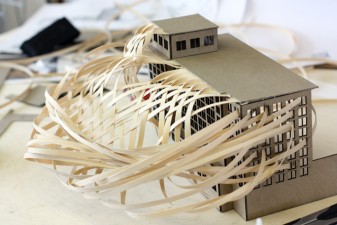Art is a broad medium for self-expression. It embodies all the creativity and imagination of the human mind, and is often associated with the stroke of a painter’s brush, a sculptor’s masterpiece taking shape or the fragile beauty of nature captured in a camera’s flash.
Because it is founded in analysis and logic, engineering can easily be interpreted as a rational and analytical contrast to the abstract environment that fosters art. Is it possible for the two disciplines to truly intersect?
Industrial Design is a field that spans the realm of both applied art and applied science. It is concerned with both the usability and aesthetics of products. Improving the look and feel of these creations involves a deep understanding of human sensibilities.
[media-credit name=”Virginia Lin | Technique – The South's Liveliest College Newspaper” align=”alignleft” width=”337″] [/media-credit]Architecture also deals with the idea of visual appeal. Choosing to design a structure with clean, elegant lines and striking symmetry suggests an artistic vision where both form and functionality play a part.
[/media-credit]Architecture also deals with the idea of visual appeal. Choosing to design a structure with clean, elegant lines and striking symmetry suggests an artistic vision where both form and functionality play a part.
Similarly, though engineers must place a great deal of importance in the mechanics of their creations, there is still room for innovative construction and creation.
“I find that the distinction between engineering and architecture, which we might today think of as the distinction between engineering and art, robs from both fields,” said Benjamin Flowers, Associate Professor in the School of Architecture.
“Art can and has been found in engineering. Works of art seek to impose on the viewer the same intense, complex experience as do high bridges, vast factories, intricate industrial machinery…or other things we might call engineering,” Flowers said.
Though the design aspect inherent in engineering can enlighten and impress as well as any piece of fine art, it stands true that engineers generally see the whole as a sum of its parts while artists focus more on the big picture.
Some engineering majors like CE and EnvE are highly technical fields, and in the traditional sense some believe that engineering works alongside art without overlapping.
“In my view, the very purpose of engineering is to apply basic science to solve real world problems. While engineers as individuals may have artistic interests in the traditional sense of the word, they are generally not expected to use them in their profession,” said Ioannis Brilakis, Assistant Professor in The School of Civil and Environmental Engineering. “However, engineering meets art all the time [as the] design of products or infrastructure that is pleasing to the customer, so both sides need to work with each other to create a better final product.”
Different though they may be, art and engineering are two worlds that collide when innovative ideas change the way people perceive the world. The followers of both disciplines are essentially invested in bringing a vision to life, and their works have inspired dreamers for centuries even before there was any distinction between the two.
“Renaissance engineers were artists. They worried about form and function, they cared about how their machines or their buildings were perceived,” said Rafael Bras, Provost and Executive Vice-President for academic affairs.
“At that time there were no architects and no engineers but master builders that gave us some extraordinarily beautiful structures. Da Vinci was the ultimate engineer and artist. Yes, he gave us beautiful sculptures and paintings but he also built extraordinary fortresses and designed bio-mimicking flying machines. The artistry of engineering is still practiced and most successful,” Bras said.
